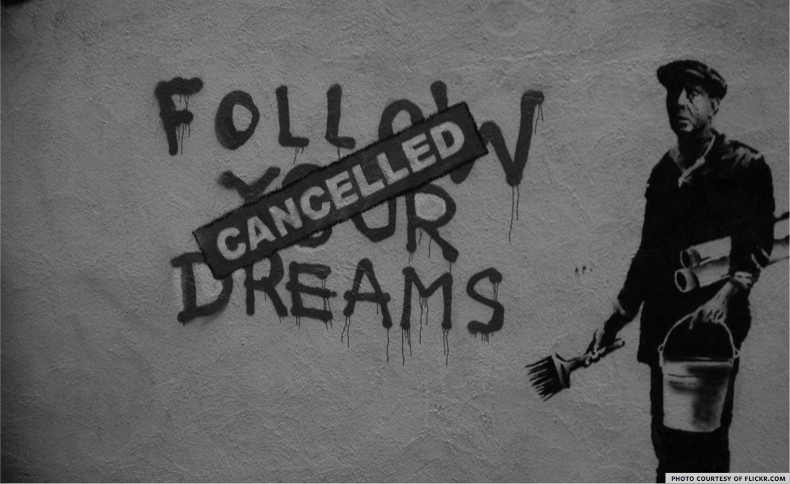
A oart from Shepard Fairey, Banksy is one of the moist well known and well-received graffiti artists in mainstream culture. Every day this month, he’s been putting out graffiti and art installments around New York City, to both acclaim and controversy. He’s affecting change and creating discourse. That’s what art does, be it New York or Toronto or any major space in between. So what’s happening at York?
Banksy’s graffiti work this month has included a massive black and white horse mural done in the Lower East Side and a small black profile of the city pre-9/11, where a bright orange chrysanthemum is exploding from one of Twin Towers.
Banksy’s graffiti work this month has included a massive black and white horse mural done in the Lower East Side and a small black profile of the city pre-9/11, where a bright orange chrysanthemum is exploding from one of Twin Towers.
Up to today, almost all of his painted pieces have been reported by news sources to have been “de-faced” by other graffiti artists.
But have they truly been “de- faced?” The basis of graffiti is movement and conversation.
Like any form of art, it relies on the basic principle of expression and the risk the expression will be criticized. Graffiti, more than any other art form, is out in and on public property, the most authen- tic format of public forum. Graffiti artists therefore would definitely contend that writing over Banksy’s graffiti is in anyway negative.
It is also important to realize that Banksy is preaching to a city which he is not native to. Many native New Yorkers feel he has no right to tell the city anything. In fact, much of the motivation behind graffiti comes from anger at the invasion of foreign images by capitalist values through advertisements and infrastructure that do not consult the public in the first place.
The people who live there have no say to how their home gets decorated. Graffiti combats that with the “if you don’t like it change it” approach. Do we see the same kind of con- versation and movement at York? It’s hard to deny that relevant, student-based artistic expression is displayed on the walls of our school.
One may drift into Accolade East and see a giant dog made out of balls or a framed picture of a tree in Vari Hall, but they have been there for years.
They don’t seem to express or represent the student population. How is it possible that in such a densely populated institution, we can seem so separated?
One can argue that a space with- out discourse is a safe space. That the sanitized art that does exist in sculpture and exhibition with a degree of permanency around our campus is nonreactive and there- fore not dangerous, which leads to less conflict and provides a more banal, arguably more comfortable experience overall.
But when we invest so much in York, don’t we have some sort of ownership of it? Why do we put up with money being poured into singularly motivated and manipulative ad campaigns like “This is My Time”?
If anything, we should be given more access to create the space around us. There’s nothing wrong with sanctions on what we put there, but by putting so much into York and its community, do we not have the right to shape the space around us the same way it shapes up?
Should it not be our time?
Pavan Kaur Ubhi
Contributor
It is also important to realize that Banksy is preaching to a city which he is not native to. Many native New Yorkers feel he has no right to tell the city anything. In fact, much of the motivation behind graffiti comes from anger at the invasion of foreign images by capitalist values through advertisements and infrastructure that do not consult the public in the first place.
The people who live there have no say to how their home gets decorated. Graffiti combats that with the “if you don’t like it change it” approach. Do we see the same kind of con- versation and movement at York? It’s hard to deny that relevant, student-based artistic expression is displayed on the walls of our school.
One may drift into Accolade East and see a giant dog made out of balls or a framed picture of a tree in Vari Hall, but they have been there for years.
They don’t seem to express or represent the student population. How is it possible that in such a densely populated institution, we can seem so separated?
One can argue that a space with- out discourse is a safe space. That the sanitized art that does exist in sculpture and exhibition with a degree of permanency around our campus is nonreactive and there- fore not dangerous, which leads to less conflict and provides a more banal, arguably more comfortable experience overall.
But when we invest so much in York, don’t we have some sort of ownership of it? Why do we put up with money being poured into singularly motivated and manipulative ad campaigns like “This is My Time”?
If anything, we should be given more access to create the space around us. There’s nothing wrong with sanctions on what we put there, but by putting so much into York and its community, do we not have the right to shape the space around us the same way it shapes up?
Should it not be our time?
Pavan Kaur Ubhi
Contributor


